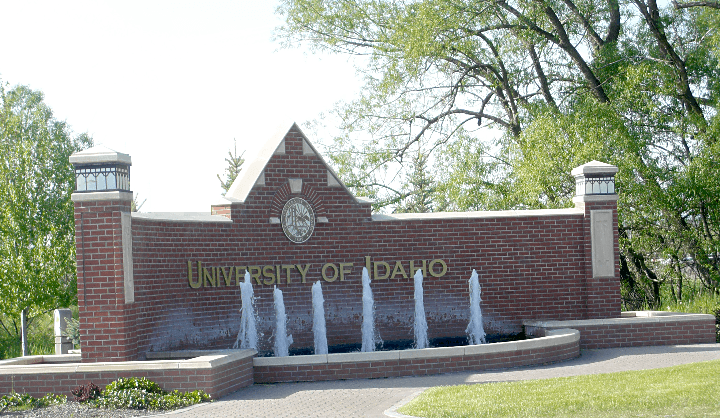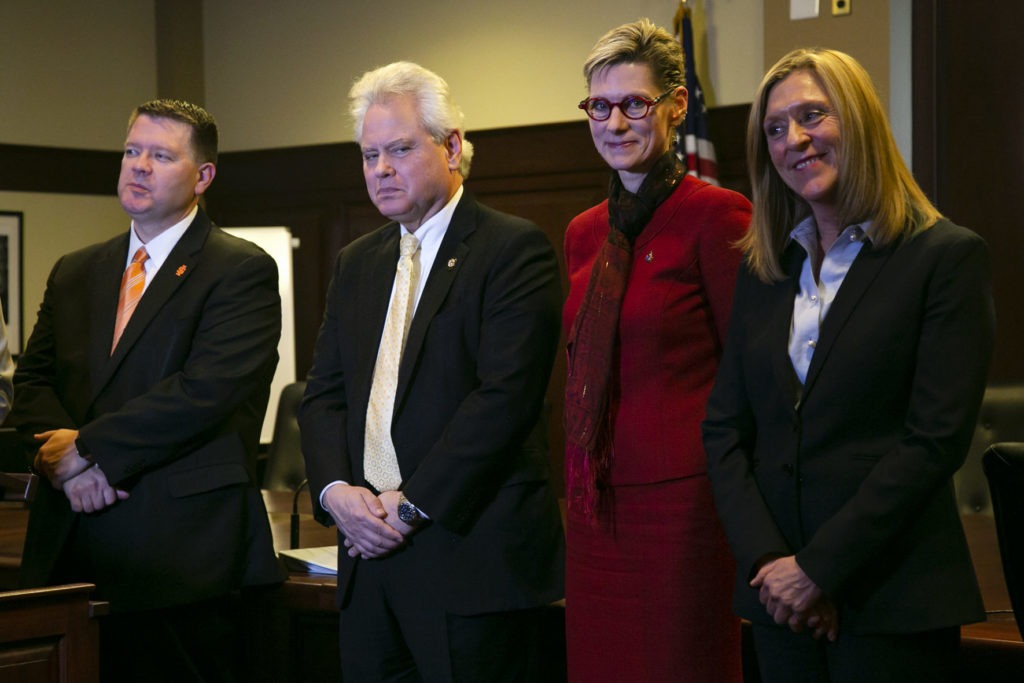
ANALYSIS: Federal COVID Relief Money Helps Fill Some Idaho College Budget Holes, But Only Some
BY KEVIN RICHERT / IdahoEdNews.org
Originally posted on IdahoEdNews.org on September 24, 2020
(EDITOR’S NOTE: Over the next year, Idaho Education News will provide in-depth, ongoing coverage of the challenges facing higher education during the coronavirus pandemic. Here’s our latest installment in this project.)
Lewis-Clark State College received $1.6 million in federal coronavirus aid this year, and plowed most of it into technology.
Web cameras. Go Pros for professors. Zoom licenses. Software for students taking classes at home. Hotspots at campus parking lots. And the list goes on. It was, as President Cynthia Pemberton puts it, like trading in the 24-color box of crayons for the big box with 100 colors.
After the pandemic passes and campuses get out of crisis mode, the technology could pay lasting dividends, serving students who don’t fit the traditional learning model. “There is a positive side to what’s going to happen,” Pemberton said.
Still, the $49.4 million in Coronavirus Aid, Relief and Economic Security Act money will only go so far on Idaho’s college campuses.
It won’t cover all of the schools’ COVID-related losses — or the revenue the schools have lost to the pandemic.
And it won’t address the long-standing shortfalls across the state’s higher education system, nor a looming budget crunch at Boise State University.
Where did the money go?
The $49.4 million didn’t come in one shot — and it didn’t all go straight to the schools.
The biggest infusion came in the spring: about $36 million for the state’s public colleges and universities. Under the CARES Act, the schools were required to give at least half of that money directly to students, some $18 million in all.

Idaho’s four college and university presidents — Idaho State University President Kevin Satterlee, University of Idaho President C. Scott Green, Boise State University President Marlene Tromp and Lewis-Clark State College President Cynthia Pemberton — had discussed a possible tuition freeze since spring. CREDIT: Sami Edge/Idaho Education News
Using $15.7 million he had at his disposal, Gov. Brad Little siphoned additional CARES Act money to the colleges and universities this summer, and earmarked $4 million for Idaho Online, a virtual learning clearinghouse that could launch in early 2021.
The CARES Act gave the colleges and universities two clear rules: They have to spend their money by the end of 2020, and they have to spend it directly to cover COVID-related costs. Salaries and benefits are off the table. Reimbursing student fees and tuition is fair game. Same goes for PPE — such as plexiglass shields to thermal stations to check temperatures as people enter a busy building.
And technology.
Like Lewis-Clark, the College of Western Idaho spent the bulk of its $2 million on technology needs that have become even more acute in the past few months. Even in the urban and suburban Treasure Valley, working from home and online K-12 classes have strained wifi systems, so on-campus hotspots allow students to park and upload or download files and assignments. For many students, the needs are more basic: access to a laptop through the computer lab.
“They have a phone, but try writing up an English 101 or 102 paper on your phone,” said Mark Browning, CWI’s vice president for college relations.
The $18 million in student aid was designed to get out the door quickly and easily. Students didn’t have to document a loss — the cost of moving back home, for instance, or lost income from a work-study job that dried up. It was up to the colleges and universities to come up with a plan for the payouts, and in many cases, they came up with a payment plan tied to need. At Idaho State University, for example, fall payments will range from $200 to $700.
The University of Idaho sent out flat payments of $513, based on the university’s estimate of an average student’s loss. The U of I has about $300,000 of its $3.5 million in student aid still available, and from here, students will have to demonstrate an expense or loss, financial aid director Randi Croyle said.
Did the money go far enough?
Not exactly. And not just in Idaho.
The $14 billion in CARES Act money fell short of meeting needs on many large campuses, the nonpartisan Washington, D.C. watchdog group Accountable.US said in a recent study. Looking at 44 of the states’ largest universities or university systems, the group found the federal money fell short of covering COVID-related losses for 36 institutions.
Boise State University was an exception, sort of. The CARES Act money covered Boise State’s COVID-related losses, the report said. However, Boise State’s athletic department is projecting $20 million in COVID losses. (Boise State didn’t respond to requests for comment on the Accountable.US study, but President Marlene Tromp has since said that a canceled football season could leave a $25 million to $30 million revenue void.)
Be it a canceled football season or concert or decreased business at the bookstore, revenue losses affect a colleges’ bottom line, and the CARES Act is not designed to cover them.

University of Idaho in Moscow. CREDIT: Robbie Giles CC BY-SA 2.5 creativecommons.org/licenses/by-sa/2.5
As the Accountable.US study also noted, the CARES Act doesn’t necessarily cover all of a college’s COVID-related expenses. The federal money will cover the “vast majority” of the U of I’s technology upgrades and safety measures, but it will still leave about a $1 million gap, controller Linda Campos said.
At its heart, the CARES Act was a one-shot response to a pandemic that hasn’t gone away. That has ISU administrators worried.
By year’s end, ISU will have handed out all of its CARES Act student aid, said Staci Phelan, the university’s interim associate vice president of enrollment management. The longer the pandemic continues, the higher the cost of campus PPE.
“Our goal is to have an on-campus experience for every student who wants to have an on-campus experience,” said Glen Nelson, vice president for finance and business affairs. “How long this lasts will be a function of how much this really affects us, negatively.”
The story at CWI is different. Officials felt comfortable enough with their budget that they decided against seeking additional short-term federal aid, this time through a Federal Emergency Management Agency.
“For the most part, we’re covered,” Browning said. “We’ve been able to make it work.”
Where do we go from here?
Earlier this month, Gov. Brad Little funneled nearly $150 million of new CARES Act money into K-12: $99 million to offset a 5 percent state budget cut, and $50 million for grants for families to offset the costs of online K-12 instruction. That means the state has injected more than $264 million of CARES Act money into supporting public schools.
Little didn’t cover higher ed’s 5 percent cut, which comes to about $15 million.
Last week, Little also was noncommittal on the idea of using budget reserves to backfill the higher ed budget. “All options are on the table to help higher education,” he said.
Higher education’s budget challenges are well-documented — and possibly spreading.
Through years of explosive enrollment growth, Boise State has avoided hard times. But in the spring, coronavirus-related revenue losses forced a round of furloughs. Last week, Tromp said job losses and program cuts are inevitable, and university officials held a virtual town hall to address faculty and staff questions.
The U of I and Idaho State are further along in the process of budget bloodletting, cutting staff and programs to erase shortfalls that predated the pandemic. The silver lining, say Nelson and Campos, is that the universities at least addressed this fiscal reckoning before also having to manage through the pandemic.
Pemberton doesn’t gloss over her financial challenges, which were also building before the coronavirus struck. Between state budget cuts, enrollment declines and lost revenues from normal campus operations, she’s looking at a $4 million to $5 million budget hole. The college is cutting more than 50 full-time positions from a staff of about 450.
Pemberton says she appreciates Little’s plight. Like college and university presidents, she said, the governor is having to juggle too many demands and not enough dollars. She also appreciates Little’s desire to make K-12 whole.
“It’s not a zero-sum game, it’s not that they won and we lost,” she said. “I’m not talking that as a value statement on higher education at all.”
Each week, Kevin Richert writes an analysis on education policy and education politics. Look for it every Thursday.
More in-depth Idaho higher education coverage
Aug. 6: A pandemic makes old problems worse for Idaho higher education
Aug. 12: Idaho campuses prepare to reopen, but will students show up?
Aug. 24: Across the state, campuses open for an uncertain new year
Originally published on IdahoEdNews.org on Sept. 24, 2020.
NOTE: Idaho Education News is an underwriter of NWPB programming, though NWPB is editorially independent. See all NWPB business supporters here. This article is re-published with permission.















